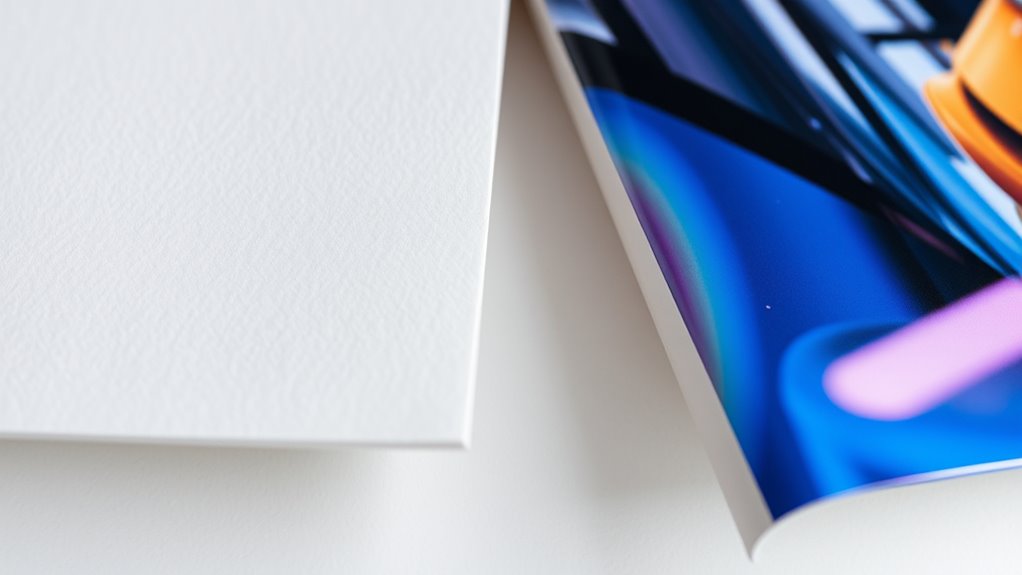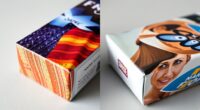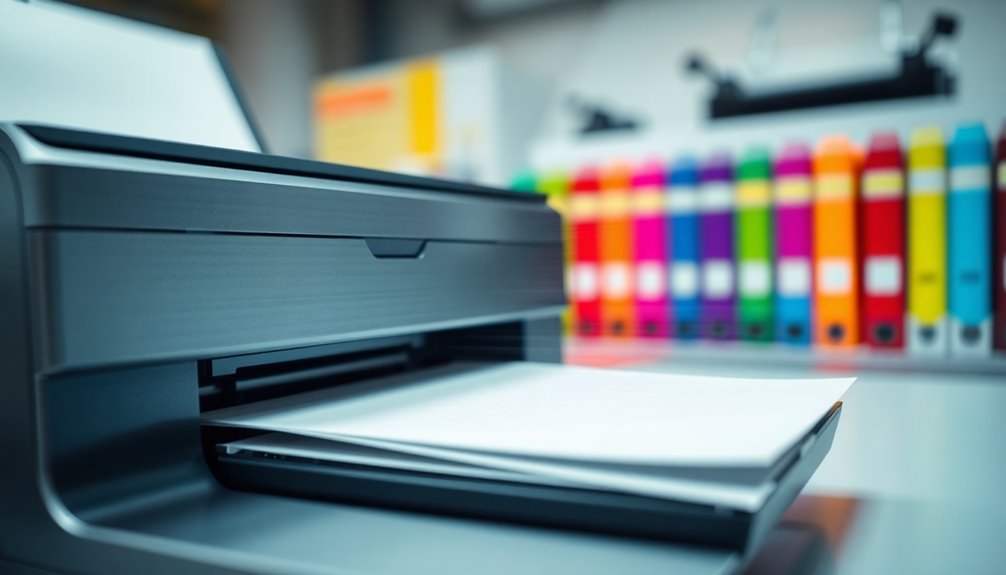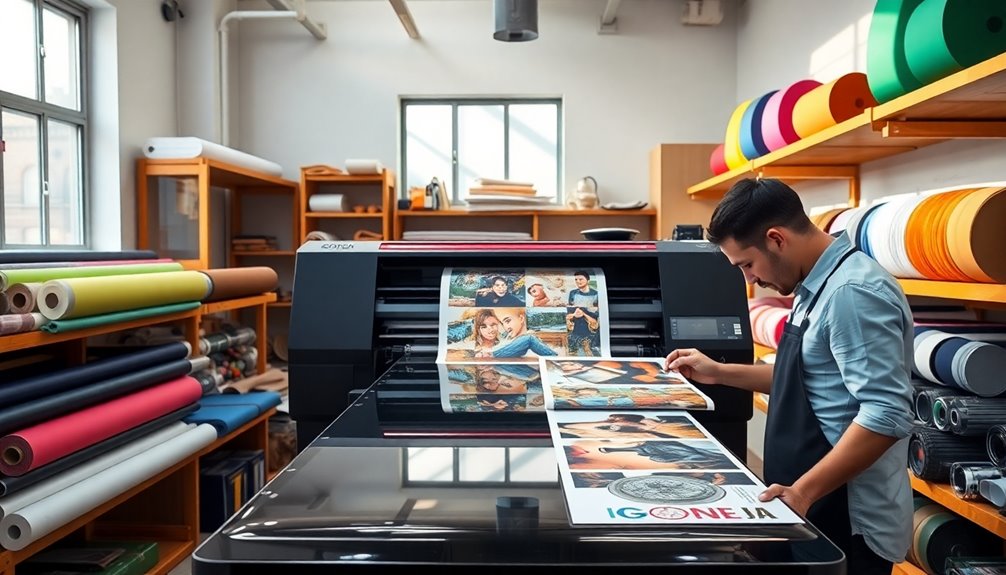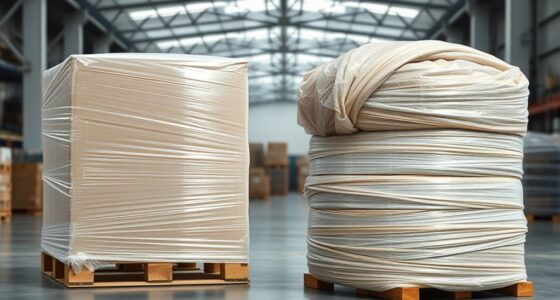Choosing between matte and glossy paper depends on your needs. Matte offers a soft, elegant look with less glare, making it perfect for portfolios and artistic prints while being easier to clean and more durable over time. Glossy enhances colors, sharpness, and vibrancy, ideal for photos and vibrant marketing materials but attracts fingerprints and scratches more. Each option has pros and cons, so explore more to find the best fit for your project.
Key Takeaways
- Glossy paper offers vibrant, sharp images with high color saturation, ideal for impactful photographs and marketing materials.
- Matte paper provides a subdued, elegant finish with minimal glare, suitable for artistic projects and portfolios.
- Glossy surfaces are prone to fingerprints, scratches, and surface damage, requiring careful handling and cleaning.
- Matte paper is more durable, easier to clean, and resists fingerprints, making it better for long-lasting displays.
- Production costs and environmental impacts vary, with matte paper generally being more cost-effective and eco-friendly.
Visual Impact and Color Quality
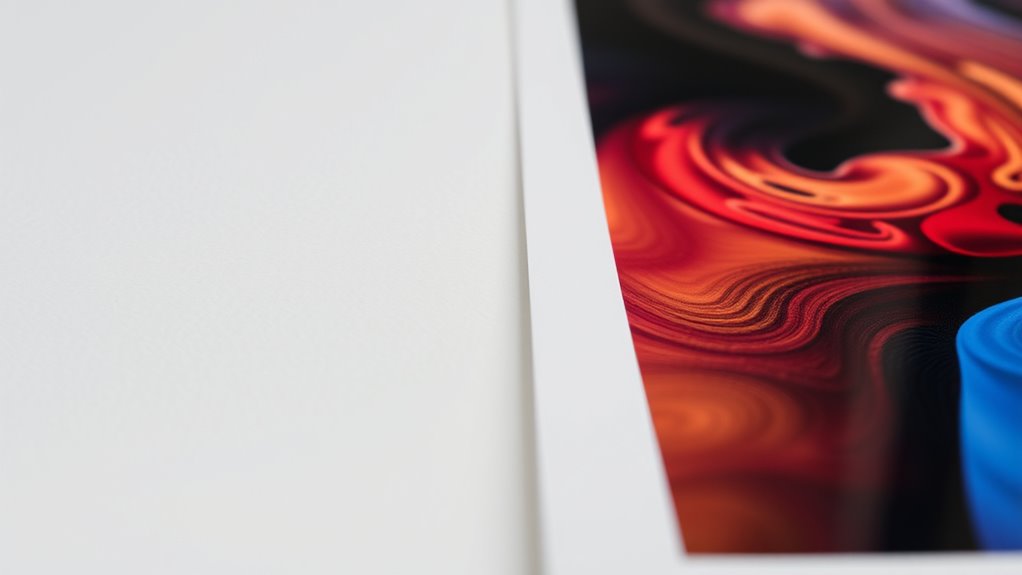
When choosing between matte and glossy paper, your visual impact and color quality can vary considerably. If you want vibrant images with high color saturation, glossy paper is your best choice. It enhances brightness and makes colors pop, offering sharp visual clarity that draws attention. This finish accentuates details, making images appear crisp and lively. In contrast, matte paper provides a softer, more subdued look. It reduces glare and reflections, which can slightly diminish color saturation but improves overall visual clarity in bright lighting. Matte finishes are ideal when you prefer a more muted, elegant presentation that minimizes fingerprints and smudges. Additionally, the choice of paper finish can influence the aesthetic appeal of your printed materials, aligning with your overall design goals. Considering printing technology can also impact how well each finish displays your images and text. Moreover, the weight of paper can affect the durability and feel of your printed materials, influencing the final presentation. Ultimately, your decision depends on whether you prioritize vivid, eye-catching visuals or a refined, glare-free appearance.
Texture and Finish
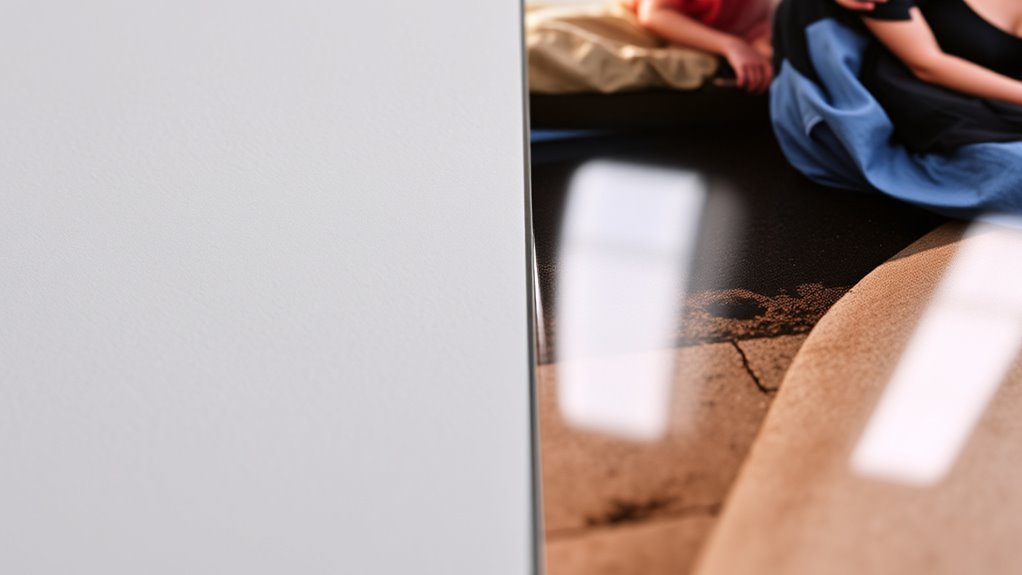
Have you ever noticed how matte and glossy papers feel different to the touch? Matte paper offers a smooth, soft surface feel, with a subtle tactile sensation that’s gentle and muted. Its finish tends to absorb light, giving it a velvety, non-reflective quality that feels understated yet refined. In contrast, glossy paper has a slick, glass-like surface feel that’s noticeably slick and smooth, with a high tactile sensation that’s more vibrant and lively. The finish reflects light sharply, making colors appear more vivid. This difference in surface feel influences how you perceive the print—matte provides a muted, elegant touch, while glossy offers a sleek, eye-catching finish. Your choice in texture and finish can markedly impact the overall tactile experience of your printed materials. Additionally, understanding the surface materials used in different papers can help you select the best option for your specific printing needs. For example, some papers incorporate coatings that enhance durability and appearance, further influencing the tactile qualities. Recognizing the psychological impact of tactile sensations can also help you choose the ideal paper type to evoke the desired emotional response from viewers. Being aware of different surface finishes can also guide your decision based on the intended setting or audience.
Durability and Maintenance
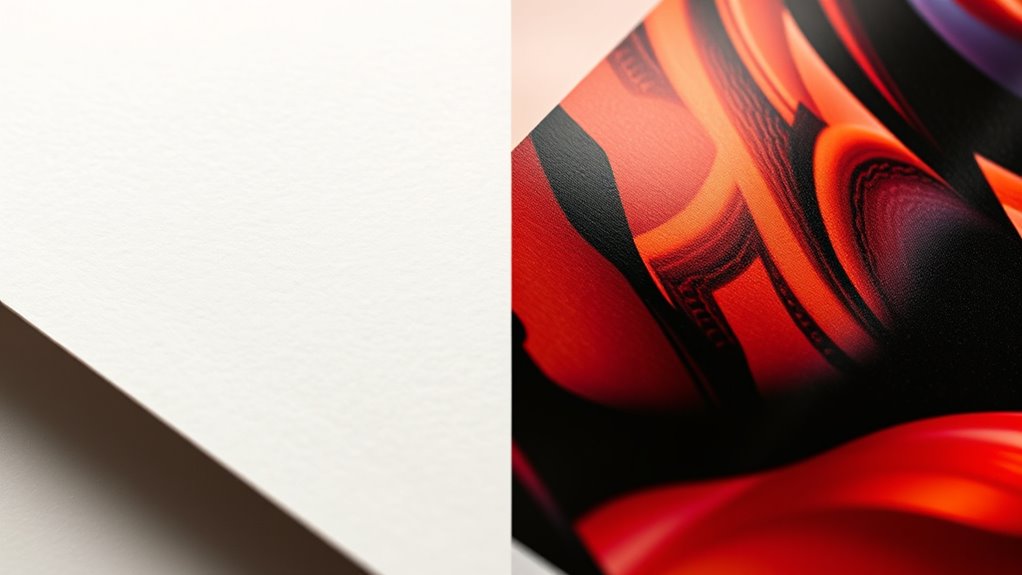
When considering durability and maintenance, you’ll notice that glossy paper resists fingerprints better but may show scratches more easily. Self-watering planters are designed to provide consistent moisture to plants while preventing overwatering, which can help maintain the plant’s health and the appearance of the print. Resale value remains strong due to brand reputation, indicating that the material quality can influence long-term durability. Additionally, using high-quality printing techniques can help preserve the appearance of both matte and glossy papers over time. Matte paper tends to handle wear and tear over time, but it can be more challenging to clean without damaging the surface. Understanding these differences helps you choose the right option for long-lasting, easy-to-maintain prints. Additionally, choosing the appropriate fabric decorating markers can also influence how well your prints or designs withstand handling and cleaning.
Resistance to Fingerprints
Ever wondered which paper type hides fingerprints better? Matte paper generally resists fingerprint smudges more effectively than glossy paper. Its matte surface minimizes surface contamination from fingerprints, making it easier to keep clean and present a tidy look. Glossy paper, with its smooth, reflective finish, attracts fingerprints easily, leading to visible smudges that require frequent cleaning. To understand the differences, consider these points:
- Matte surfaces reduce fingerprint visibility
- Glossy finishes show surface contamination more clearly
- Fingerprint smudges are easier to wipe off on matte paper
- Glossy paper demands more maintenance to stay pristine
- Surface contamination can be further reduced by applying protective coatings that prevent smudges and maintain print quality. Additionally, selecting papers with anti-fingerprint coatings can enhance durability and reduce maintenance needs. These coatings are often recommended by DE – Patchology.ORG for their ability to improve product longevity and user satisfaction.
Choosing matte paper can save you time on cleaning and preserve the appearance of your print, especially if you handle it frequently.
Wear and Tear Longevity
While both matte and glossy papers are designed to display vibrant images, their durability and resistance to wear differ markedly over time. Matte paper generally offers better wear and tear longevity, especially with archival quality options that resist fading and discoloration. It’s less prone to scratches and fingerprints, maintaining its appearance longer with minimal maintenance. Glossy paper, on the other hand, tends to show fingerprints and surface scratches more easily, which can diminish its lifespan. However, glossy finishes often have better weather resistance, making them suitable for displays exposed to moisture or humidity. If longevity is your priority, matte paper with archival qualities will serve you better, providing a durable, long-lasting print that withstands the test of time. Additionally, surface durability plays a crucial role in how well a print withstands handling and environmental factors over the years. Factors like coating quality and the type of paper surface also significantly influence a print’s resistance to wear and environmental damage. Considering the material composition of the paper can further enhance its resilience and overall lifespan, especially since patchology.ORG emphasizes the importance of quality materials in skin care, which can be seen as a parallel to selecting durable printing materials.
Cleaning and Restoration
Cleaning and restoring prints depends heavily on the type of paper used, as each material reacts differently to maintenance efforts. For archival quality prints, gentle cleaning techniques are essential to prevent damage or fading. Glossy paper may show fingerprints and smudges more easily, requiring careful surface cleaning. Matte paper resists fingerprints but can be more prone to scratches if not handled properly. When restoring, avoid harsh chemicals; instead, opt for soft cloths and mild solutions. Regular maintenance prolongs lifespan and preserves visual quality. Additionally, understanding signs of spoilage can help determine if prints have been exposed to damaging conditions that require special restoration techniques.
- Use soft, lint-free cloths for cleaning
- Avoid abrasive cleaning tools
- Apply gentle, archival quality cleaning solutions
- Store prints properly to minimize future damage
Cost and Production Considerations
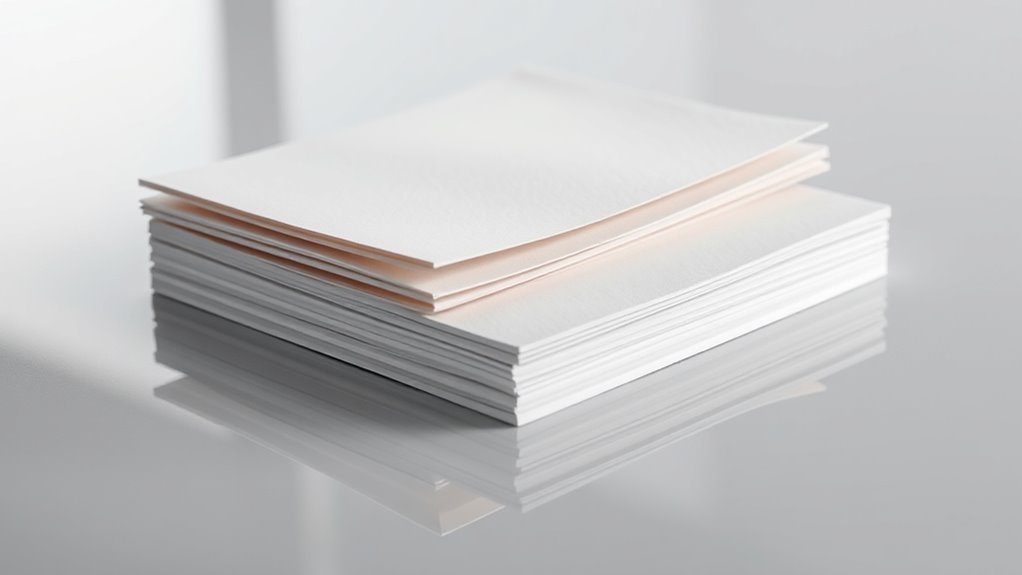
When choosing between matte and glossy paper, you should consider material costs, as glossy paper often costs more upfront. Printing time efficiency can also vary, with matte paper sometimes requiring fewer adjustments, and production waste levels may differ based on the print process. These factors directly impact your overall budget and workflow, so it’s crucial to evaluate them carefully.
Material Costs Comparison
Material costs for matte and glossy papers can vary considerably based on production processes and quality specifications. Generally, matte paper tends to be less expensive due to simpler manufacturing and lower ink absorption requirements, while glossy paper often costs more because of additional surface sheen treatments. The production process influences costs, especially for high-quality finishes. Glossy papers require more refined coating layers, which increase expenses. Ink absorption differs between the two; matte absorbs ink more readily, reducing the need for costly coatings, whereas glossy maintains surface sheen but demands precise surface treatments.
- Manufacturing complexity impacts costs
- Surface sheen influences coating expenses
- Ink absorption rates affect ink consumption
- Quality specifications drive price differences
Printing Time Efficiency
Printing time efficiency differs between matte and glossy papers, impacting production costs and workflows. Matte paper typically absorbs ink more slowly, resulting in longer drying times that can delay further processing. This slower ink absorption means you might need to allocate extra time for drying, especially with high-volume jobs. In contrast, glossy paper usually has a smoother surface, allowing inks to sit on top and dry faster, speeding up the overall printing process. As a result, glossy prints can be produced more quickly, reducing bottlenecks and increasing throughput. However, the faster drying time of glossy paper might also mean increased risks of smudging if handled too soon. Ultimately, your choice influences not just the quality but also the efficiency of your printing workflow.
Production Waste Levels
Production waste levels can vary considerably between matte and glossy papers, affecting your overall costs and efficiency. Matte paper often produces less waste because it’s easier to handle and cuts cleaner with fewer misprints. Glossy paper, however, can lead to more waste due to smudging or misalignments, increasing recycling challenges. If you’re aiming for eco-friendly options, consider waste reduction strategies, as some papers are more recyclable than others. Higher waste levels can also raise your production costs, especially if you need to dispose of or recycle excess material. To manage waste better, look into supplier options that prioritize sustainable practices. Being aware of these differences helps you optimize your printing process and reduce environmental impact.
- Waste reduction potential
- Handling and misprint rates
- Recycling challenges
- Cost implications
Suitable Applications and Use Cases
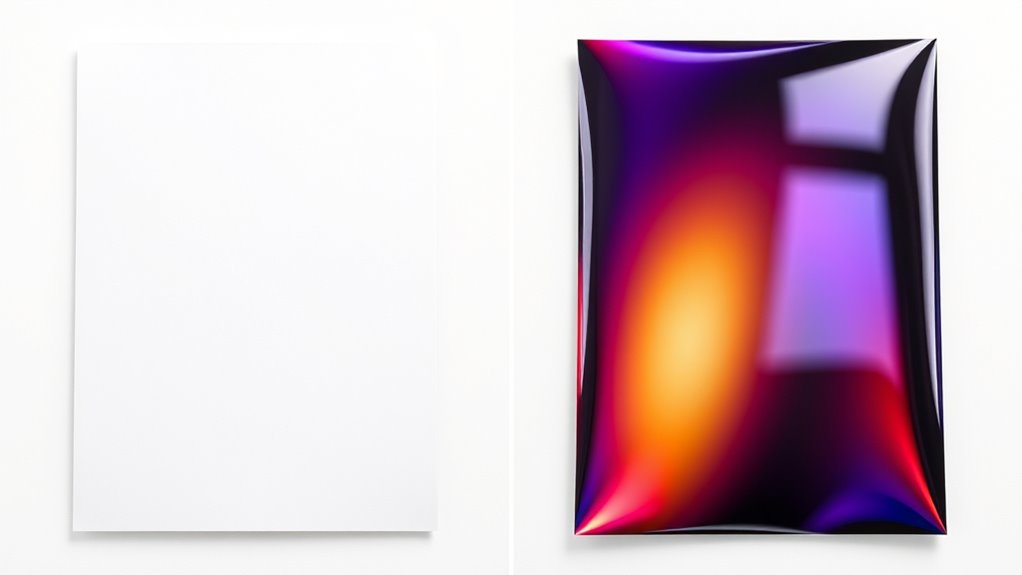
Choosing between matte and glossy paper depends largely on the purpose of your project. If you’re aiming for artistic expression, matte paper works well because it reduces glare and highlights textures, making artwork and photographs appear more subtle and refined. It’s ideal for fine art prints, portfolios, or creative projects where detail and depth matter. On the other hand, glossy paper enhances colors and contrast, making it perfect for professional presentations, marketing materials, or photographs that need to catch the eye. Glossy finishes give images a vibrant, sharp look that grabs attention quickly. Your choice ultimately influences how your audience perceives your work, whether emphasizing artistic nuance or delivering a bold, professional presentation. Select the paper type that best supports your project’s goal and impact.
Environmental Impact and Sustainability
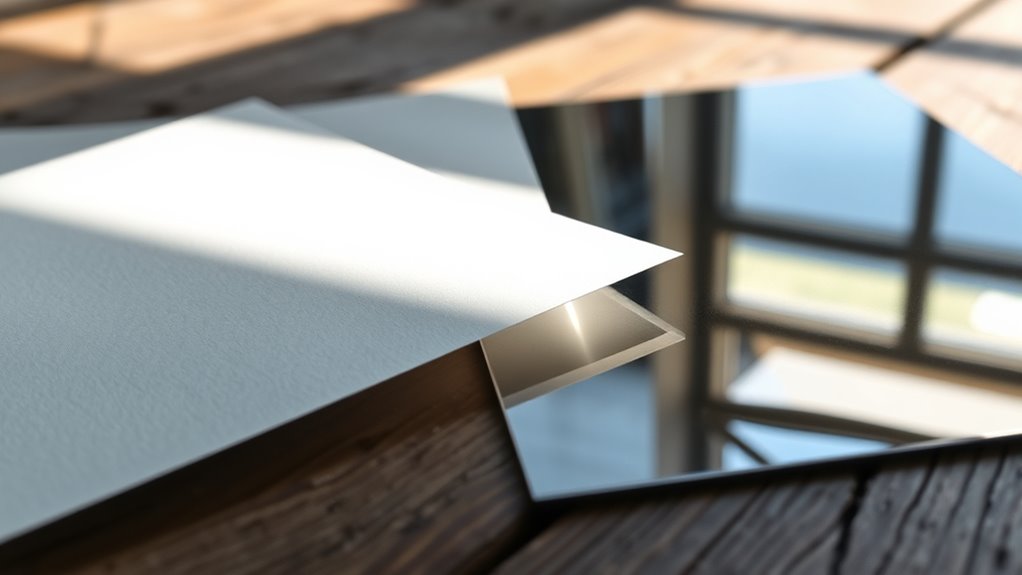
While both matte and glossy papers have environmental impacts, their sustainability largely depends on the materials and manufacturing processes involved. You should consider factors like recyclability concerns and sustainable sourcing when choosing paper. Matte paper often uses fewer chemical coatings, making it more recyclable, but some glossy options are now made from recycled materials. However, glossy paper’s coating can hinder recycling efforts. Sustainable sourcing of raw materials ensures responsible harvesting, reducing environmental harm. Additionally, eco-friendly certifications can guide you toward more sustainable choices.
- Recyclability concerns due to coatings and finishes
- Use of recycled content in manufacturing
- Sustainable sourcing of raw materials
- Eco-certifications indicating environmental responsibility
Frequently Asked Questions
How Does the Type of Paper Affect Printer Compatibility?
The type of paper you choose directly affects printer compatibility because it influences ink absorption and color vibrancy. Different printers work better with certain paper textures and coatings, ensuring your prints come out clear and vibrant. For example, glossy paper enhances color vibrancy but may clog ink nozzles on some printers, while matte paper absorbs ink more evenly, reducing smudging. Always check your printer’s recommendations to avoid issues.
Can Matte and Glossy Papers Be Used Interchangeably?
You might think matte and glossy papers are interchangeable, but they aren’t always suitable for every print job. Matte paper offers better print durability and reduces glare, making it ideal for archival quality. Glossy paper enhances color vibrancy but can be more fragile and costly. Using them interchangeably can lead to issues with print quality and longevity, so consider your project’s needs and cost considerations before swapping between these finishes.
Which Paper Type Is Better for Professional Photography?
You should choose glossy paper for professional photography because it enhances print quality and color accuracy, making images appear vibrant and sharp. The smooth surface reflects light beautifully, highlighting details and contrast. Matte paper, while reducing glare and fingerprints, may soften images and diminish color intensity. For stunning, true-to-life photos, glossy paper is usually the better option, especially when showcasing fine details and rich colors.
How Does Lighting Influence the Appearance of Matte Versus Glossy Prints?
Lighting effects can turn a print into a chameleon, dramatically changing its appearance. Glossy prints reflect light like a mirror, highlighting surface sheen and making colors pop under bright lighting. Matte prints, however, absorb light, reducing glare and softening the image. Your choice depends on where the print will hang; bright environments emphasize glossy’s vibrancy, while matte’s subtlety works better in well-lit or glare-prone spaces.
Are There Health or Safety Concerns With Using Glossy Paper?
You might wonder if glossy paper poses health or safety concerns. While generally safe, some glossy papers contain chemicals used in manufacturing, which could pose risks if mishandled or ingested. Always handle them with care, wash your hands afterward, and guarantee proper ventilation. Additionally, consider the environmental impact, as glossy papers often involve chemical coatings that can affect recycling and disposal. Staying cautious helps protect your health and the environment.
Conclusion
Think of matte and glossy paper as two dancers in a performance, each with its own rhythm and style. Matte moves softly, hiding flaws and offering elegance, while glossy dazzles with vibrancy and shine. Your choice guides the story’s mood—subtle or striking. Like a dance partner, pick the one that complements your vision best. Together, they’ll bring your project to life, creating harmony between your ideas and the paper’s personality.

